Lowell Week in Review: January 28, 2018
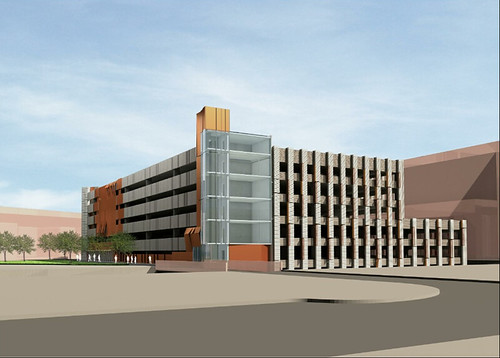
Hamilton Canal Parking garage rendering
Development News and Updates
Looking at the “pending projects” pages for the Lowell Planning Board, Zoning Board of Appeals and Conservation Commission always provides some interesting information. Here are some new projects, or modified old projects, that caught my attention.
Hamilton Canal District Parking Garage
At the end of December, VHB of Watertown, the civil engineering firm retained by the city for the construction of the big parking garage within the Hamilton Canal District, submitted a request for a number of variances to the Zoning Board of Appeals. The variances sought mostly involved setbacks from the boundary lines of the lot, which is Lot 14 within the HCD. I believe that because this application is on behalf of the city, the Zoning Board’s involvement is advisory. According to the plans submitted with the application, the garage will have 988 spaces and will consist of eight levels or tiers (basement tier, canal tier, street tier, second tier, third tier, fourth tier, fifth tier and top tier). No indication of when work will begin, but it’s nice to finally see some plans and a rendering of the building’s expected appearance (pictured above).
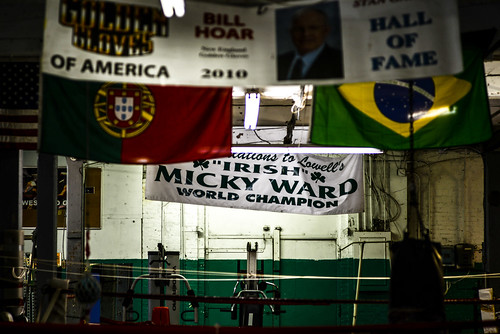
Ramalho’s West End Gym. Photo by Tony Sampas
850 Lawrence St
Best known now as Ramalho’s West End Gym, the official name for this structure is the Waterhead Mill. It once produced corduroy cloth. It has been owned since 1998 by Hideaway Farms Real Estate Trust, but the application recently filed with the Planning Board states that the applicant, Heritage Properties, has an agreement to purchase the property with Hideaway. The developer (Heritage) proposes 71 single bedroom units in the existing building, presumably rental apartments.
JDCU Property on Merrimack Street
The former Jeanne d’Arc Credit Union headquarters at the corner of Merrimack, Cabot and Market Streets is back with another application for a private dormitory. The proposal, by Union Lowell LLC, calls for a new 6-story building, consisting of 163 dormitory units containing 466 bedrooms. The developer will provide a total of 263 parking spaces: 93 onsite; 120 at the Transfiguration Church; and 50 at the Ayotte Garage. The developer will also contribute $800,000 to a proposed (?) neighborhood parking facility.
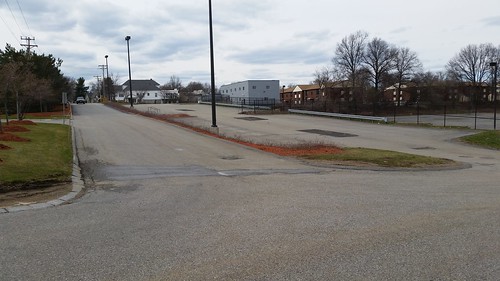
Wellman St, looking towards Stevens St. Lowe’s parking lot to left
42 Wellman Street
This property is off Chelmsford Street, near Lowe’s, and alongside the Lowell Connector. In 2016, the City Council re-zoned the parcel from high-rise industrial to multifamily residential. I believe the owner, CP Land Partners, LLC, had received the necessary board permissions to construct 240 apartment units on the site. However, on January 19, 2018, the owner sold the property to SMC Residences at Cross Point LP for $7.5 million. Presumably the new owner will go forward with construction of this project.
535 Pawtucket Boulevard
This is a parcel along the Pawtucket Boulevard at the corner of Melrose Ave (the AAA office is on the opposite corner). This proposal calls for the construction of a 4-story building containing 23 condominium units, each about 1200 square feet in size.
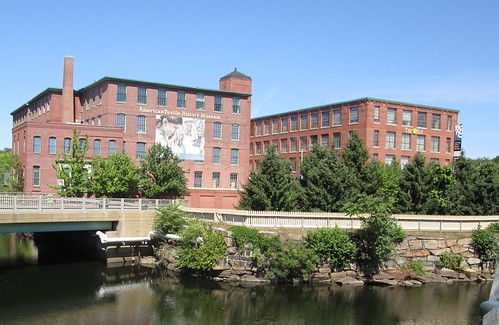
491 Dutton St
491 Dutton Street
This is the American Textile History Museum building. The owner proposes constructing 13 condominium units, each between 940 sf and 1600 sf in size, on the third and fourth floors of the building.
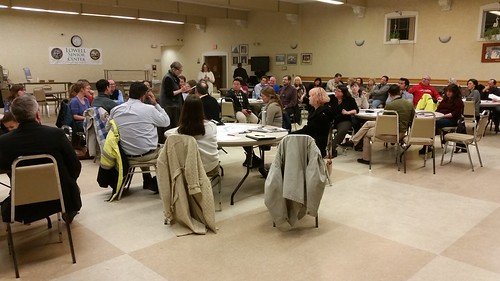
Open Space Plan public meeting
Lowell Open Space Plan
This past Wednesday evening, about 50 people gathered at the Lowell Senior Center for the first public session on the 2018 Lowell Open Space Plan. The Commonwealth of Massachusetts requires communities to update open space plans every five years and Lowell last did it in 2013. The new plan calls for extensive public input and review, with the final plan being approved by the city council and then by the state. Having an updated plan is a pre-condition to obtaining state funds for parks and open space.
The objective of Wednesday’s meeting was to find out from attendees (1) how they currently use the city’s open spaces, and (2) what improvements and additions are desired. The process calls for two other formal public meeting, one to review “what we have learned” from earlier sessions, and the other to review the draft action plan. In between, the two DPD staffers in charge of this project, Yovanni Baez-Rose and Christine McCall, will attend numerous community meetings and other gatherings to obtain information from more residents, and will conduct a survey to gain similar information.
After a brief introduction. People broke up into eight groups, each with a DPD facilitator. Each group was asked to answer the two questions posed earlier (how do you currently use open space, and what more would you like).
Two items that came up repeatedly from multiple groups weren’t about the parks themselves. The first was the difficulties people have just getting to the parks. Kittredge Park at the corner of Andover and Nesmith streets was cited as an example. Unless you live on the same side of the intersection as the park, you are unlikely to walk there because crossing either road or the intersection of the two is so hazardous. The same could be said for those living on the south side of the Merrimack River (along Pawtucket and Middlesex streets). Just cross the Rourke or O’Donnell bridges and the Vandenberg Esplanade and all the amenities on that side of the river are available to you. But trying to get to the bridges on foot is a challenge. This is also true for everyone living in Pawtucketville. Having the riverbank as part of the neighborhood is a great feature, but who wants to cross Pawtucket Boulevard on foot? Even with crossing lights, it is still a hazardous undertaking.
The other common desire was for the city to better inform the public about what programs are available at what parks, and to even promote the existence and availability of the parks. Someone used the term “social marketing” to describe what is needed. Another suggestion was for the city to send out a regular “parks and outdoor activities” e-mail newsletter, much like the one already done for cultural affairs.
Besides these two common concerns, here are some of the other items discussed:
- More pop-up activities in parks, like ping pong tables and cornhole sets (aka bean bag toss)
- Downtown residents wanted more park-like places to gather after work, and for the places that already exist, more people and better lighting to increase the feeling of safety.
- Also downtown, not enough play areas for kids; recommend climbable sculptures that double as public art.
- A public boathouse on the Merrimack where small crafts like kayaks and canoes could be stored. Also, sailing and boating courses.
- Dye the canals green on St. Patrick’s Day.
- Shedd Park is so successful that it has a (car) parking problem.
- Have public bathrooms at larger parks.
- More winter activities, especially outdoor skating opportunities (at least half the groups came up with this). Also, more cross country skiing and sledding opportunities and information about both.
- More benches in parks and on the routes to parks.
- More opportunities for bicycling, especially unpaved trails (that could also be used for jogging).
How our open space is used and maintained is a huge contributor to quality of life in the city. It’s something that affects everyone. To share your thoughts on this topic, email OpenSpace@Lowellma.gov and watch for future Open Space Public Meetings.
Gatherings like this that call for citizen input are always energizing events for those who attend. Past experience suggests, however, that these plans, once completed, serve merely as a means of checking a box on applications for state funds. I say that because in the recent past, plans like this one, once they are finished, are routinely ignored by city councilors. That sends the unfortunate message that citizen input is obtained not because those in city government value it, but because it is a prerequisite to obtaining state funds. Maybe this time it will be different.
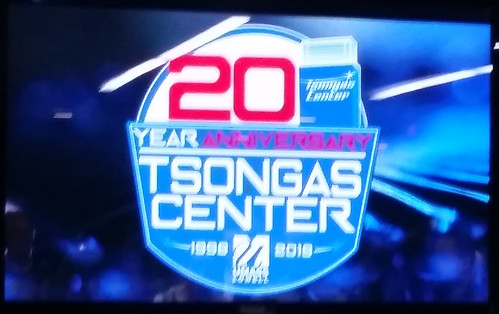
Tsongas Arena Turns 20
Just before UMass Lowell’s thrilling men’s hockey victory over Boston College on Friday night, the University hosted a gathering of many who were instrumental in the creation of the Tsongas Arena, now the Tsongas Center, which opened on January 25, 1998, with another River Hawks hockey game.
A number of people spoke during the event. Here’s a brief summary of what each one said:
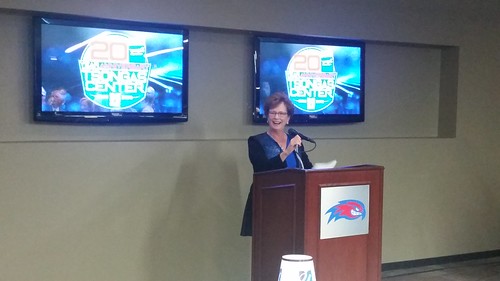
UMass Lowell Chancellor Jacquie Moloney
UMass Lowell Chancellor Jackie Moloney said that she is thrilled by the way the Tsongas Center provides a place for families and the community to gather for sporting events, concerts, graduations, and much else. She also emphasized the substantial amount of economic activity that the arena brings to the city of Lowell each year.
Congresswomen Niki Tsongas reminded everyone that Paul Tsongas never saw the arena (he died while it was under construction). She said he would be so proud of it and what it has become. She said she’s often asked about Paul’s reaction to the arena being named for him. She said that when that news came, he was already very sick, but he was very gratified by it.
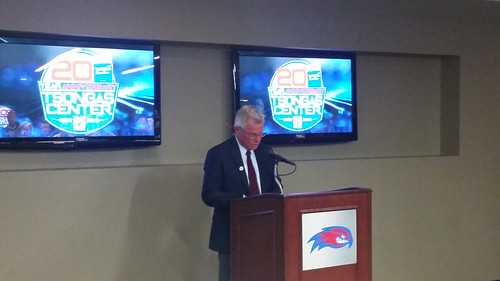
Brian Martin
Brian Martin (was City Manager during construction of the arena) said Paul Tsongas loved his family most, but he also loved Lowell. When Paul had an idea about improving the city, he was relentless. He was also infectious. Brian cited citizen support for the arena as shown by the 1994 referendum in which people voted 53% to 47% to allow public funds to be used in the construction of the arena. Brian said the city’s total contribution was $4.8 million. For that, the city received a complex with a total cost of $70 million when you factor in related infrastructure like the relocation of the post office and the River Walk. Brian closed by saying that getting the arena done really transformed the way the city was viewed statewide, and it paved the way for other projects that followed.
State Senator Eileen Donoghue said it was the great debate over the arena that got her involved in politics in Lowell. She said the arena was the first true public-private partnership in Lowell and it set a precedent for other big projects that followed. Donoghue said getting the arena built was an example of what a Gateway city can do. She then said Lowell embodies a quote from basketball great Michael Jordan: “Talent wins games; teamwork wins championships.”
Jack Costello (publisher of Lowell Sun and chair of the Arena Commission twenty years ago) praised former UMass Lowell hockey coach Bill Riley (who was present) for providing such great leadership in the early days of college hockey in Lowell. He and his teams proved that college hockey was popular in Lowell which gave proof of the need for an arena like this.
John Cox (the State Representative credited with being primarily responsible for obtaining the $20mil in state funding for the arena) said that there was great competition in the legislature for this money (and opposition to Lowell getting so much of it). He said the arena has been a success for three reasons: (1) it created a great venue for entertainment and events for the region; (2) building and having it brought Lowell to the next level of cities; and (3) the process and the existence of the arena brought the city and UMass Lowell closer together.
State Representative Dave Nangle picked up the theme of the arena as precedent and cited projects like the reinvention of Julian Steele, the widening of Route 3, the Hamilton Canal District, and the Lowell Judicial Center as projects that would not have happened but for the arena.
State Representative Tom Golden said the arena succeeded because of teamwork by all involved. He also thanked Paul and Niki Tsongas for their service to Lowell.
City Manager Kevin Murphy reiterated the importance of partnerships and working together as a team.
Mayor Bill Samaras said that in his time as Headmaster of Lowell High, he watched many projects unfold, but he feels the arena was the best of them. He said having the arena makes it much easier to sell the city as a place to which people and companies should come.
Steve Panagiotakos (a state representative at the time the arena was built) gave some of the behind-the-scenes State House history from 20 years ago. He said that he had opposed House Speaker Charlie Flaherty on many things and so he was unable to get anything from the Speaker. He said Ed LaLacheur, while well-respected in the House, wasn’t prepared to make a big “ask” at that time (LeLacheur was later instrumental in obtaining the funds needed to construct – you guessed it – LeLacheur Park). This left the third state rep, John Cox, to obtain the money in the House, which he did, according to Steve, who also reminded everyone that then State Senator Dan Leahy also was critical by keeping the project alive in the Senate. Steve fast-forwarded ten years to the negotiations between the University (under Marty Meehan) and the city (under Bernie Lynch) in which Steve was called in to serve as a mediator. Steve joked he felt more like a psychiatrist than a mediator because of the intensity of the negotiations between Meehan and Lynch, but the deal got done. Steve closed by saying that the arena at first divided the community but that once the decision was made to build it, everyone united behind the effort. That, he said, ignited a “can do” reputation for the city. Without the arena, there would be no ball park, no Julian Steele project, no widening or Route 3, and the benefits continue today with the Hamilton Canal District and the Judicial Center.
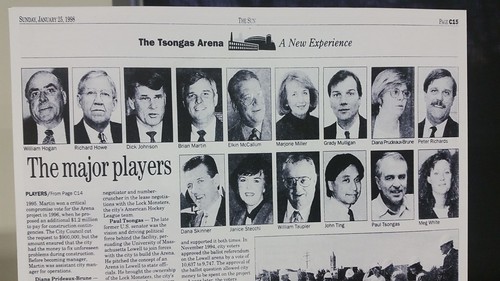
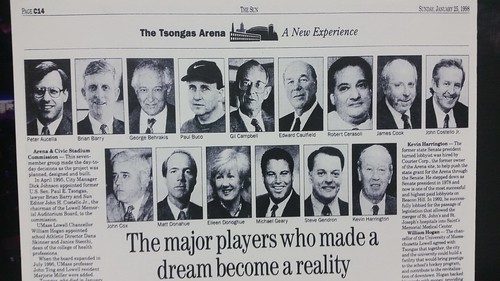
Great blog.
Thanks for your updates.
The ZBA permit for the garage isn’t advisory. Municipal projects aren’t exempt from zoning.
Public school projects have to allowed by right in every zoning district, but the rest of municipal operations do not. And everything, school side or city side, has to meet the dimensional requirements or get a variance.
Love your Lowell Week in Review column. Extremely informative. Keep them coming. Thank you
Joe, thanks for clarifying that the zoning ordinance is fully applied to city projects.